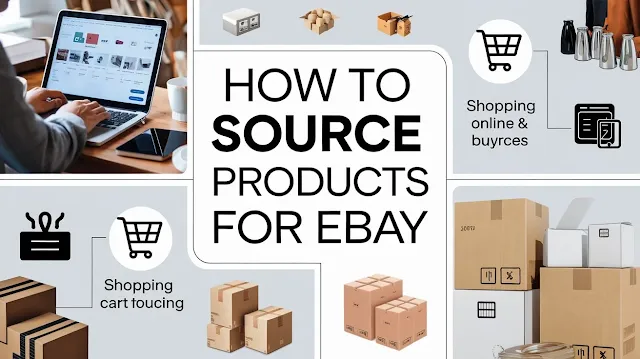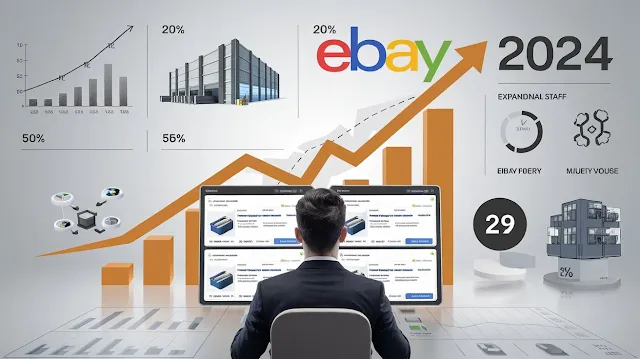How to Start a Small Business on eBay in 2024: The Ultimate Guide
In 2024, starting a small business on eBay has never been more accessible or lucrative. Whether you're selling handmade crafts, vintage collectibles, or reselling products from suppliers, eBay offers a user-friendly platform with access to millions of buyers worldwide.
In this comprehensive guide, we'll walk you through everything you need to know to get your eBay business up and running successfully, from setting up your account to optimizing your listings for visibility and profit.
Why Start a Business on eBay in 2024?

eBay remains one of the leading global eCommerce platforms, with over 182 million active buyers worldwide. Starting a small business on eBay offers the following advantages:
- Low Startup Costs: Compared to other platforms like Amazon or Shopify, eBay’s fees are more affordable, and no upfront investment is required.
- Diverse Product Categories: eBay allows you to sell virtually anything, from electronics and fashion to collectibles and home goods.
- Established Customer Base: With millions of active users, you're instantly connected to a vast network of potential buyers.
- Flexible Business Model: You can run your eBay business part-time or scale it to a full-time venture.
In a marketplace as competitive as eBay, leveraging advanced tools and strategies like SearchGPT can significantly boost your small business’s success. Learn more about integrating AI tools into your marketing efforts by reading How SearchGPT is Transforming Small Business Marketing.
Setting Up Your eBay Business Account
To start selling on eBay, follow these steps:
- Create an eBay Business Account: Go to eBay's signup page and select “Create a Business Account.” Provide the necessary details, including your business name, email, and payment information. Ensure your business account is verified to gain access to seller tools like bulk listings and promotional options.
- Choose a Store Subscription: eBay offers several store subscription levels, ranging from basic to premium. Evaluate each plan based on your business's scale, volume of sales, and need for additional marketing tools.
- Set Up Payment Options: Ensure you have a secure payment option for customers, with PayPal and credit card payments being the most popular.
- Establish a Seller Profile: Create a professional seller profile that includes your business's story, values, and policies regarding shipping, returns, and customer service. A transparent seller profile increases customer trust and boosts conversion rates.
Choosing Your Niche and Products
Selecting the right niche is key to your eBay business's long-term success. Consider the following factors:
- Market Demand: Research what products are trending in 2024. Utilize eBay’s Advanced Search and Google Trends to identify high-demand products with low competition. For additional insights, check out this comprehensive guide on Ecommerce Success: 2024 Trends and Strategies.
- Profit Margin: Calculate potential profits by subtracting the cost of goods sold (COGS), shipping, and eBay fees. Aim for products with at least a 30-40% margin to ensure profitability.
- Competition Analysis: Research your competition. Analyze successful eBay sellers in your niche by reviewing their pricing, customer reviews, and product descriptions. Use this data to position your business competitively.
How to Source Products for eBay
There are multiple ways to source products for your eBay business:
- Dropshipping: Dropshipping allows you to sell products without holding inventory. Find reliable suppliers who will fulfill orders directly to your customers. To learn more about starting a dropshipping business, visit Dropshipping: How to Start and Make Money in 2024.
- Wholesale Suppliers: Purchase bulk products at wholesale prices and resell them on eBay for a profit. Look for suppliers on platforms like Alibaba, Wholesale Central, or even local trade shows.
- Liquidation and Auctions: Buy liquidation pallets from websites like Liquidation.com or auction sites where businesses sell excess inventory. These products can often be purchased at steep discounts.
- Private Labeling: For sellers looking to build a brand, consider private labeling. This involves manufacturing a product and branding it as your own, giving you full control over pricing and packaging.
Creating Optimized Listings that Rank Higher
Your eBay listing is your storefront. To attract buyers and rank higher in eBay’s search results, you need optimized listings:
- Title Optimization: Use descriptive, keyword-rich titles (under 80 characters). Include essential keywords buyers are searching for, such as “new,” “vintage,” “free shipping,” and product-specific terms.
- High-Quality Images: Upload multiple high-resolution images showing the product from various angles. eBay allows up to 12 photos per listing, and listings with more photos often outperform those with fewer.
- Detailed Descriptions: Write detailed product descriptions, covering all aspects of the item, including condition, dimensions, and any unique selling points. Use bullet points for easy readability.
- Pricing Strategy: Set a competitive price by researching what similar items are selling for. Consider offering free shipping, which can improve your listing's visibility.
eBay SEO: Maximizing Visibility in Search Results
Understanding eBay’s search algorithm, Cassini, is crucial to driving organic traffic to your listings. Here’s how to optimize your eBay SEO:
- Use Relevant Keywords: Incorporate the primary keyword in your title, product description, and item specifics. Use secondary keywords like “best eBay sellers 2024” or “how to sell on eBay” naturally throughout the content.
- Item Specifics: eBay’s algorithm places a high value on item specifics such as brand, model, size, color, and condition. Fill out all item specifics to improve your listing’s relevance in search results.
- Seller Performance: eBay ranks sellers with high ratings, fast shipping, and a low return rate higher. Strive for Top-Rated Seller Status by providing excellent customer service and meeting eBay’s seller performance standards.
Shipping, Customer Service, and Building Trust
Providing a seamless customer experience is essential for building trust and encouraging repeat purchases. Here’s how to ensure a great experience:
- Fast Shipping Options: Offer fast and reliable shipping. Consider using eBay’s Global Shipping Program to reach international customers without hassle.
- Clear Return Policy: A generous return policy (such as a 30-day free return policy) can increase buyer confidence, leading to more sales.
- Responsive Customer Service: Respond to customer inquiries quickly and professionally. Use eBay’s messaging system to address any issues, resolve disputes, and maintain a positive seller rating.
Scaling Your eBay Business in 2024
Once your eBay store is established, scaling becomes the next priority. Here’s how to grow your business:
- Expand Product Range: Introduce new product categories to attract a wider audience. Diversification can reduce risks and increase sales.
- Invest in Marketing: Use eBay’s Promoted Listings feature to advertise your products to a broader audience. Additionally, integrate social media marketing to reach more potential buyers.
- Leverage Automation Tools: Tools like SearchGPT can automate repetitive tasks such as listing products, pricing, and customer support, allowing you to focus on scaling your business.
Conclusion
Starting a small business on eBay in 2024 offers entrepreneurs an excellent opportunity to tap into a massive global marketplace. By following the steps outlined in this guide—setting up your business account, optimizing your listings, focusing on customer service, and leveraging marketing tools—you can build a successful and profitable eBay business.
For more insights into starting a small business on other platforms, check out our guide on Starting a Small Business on Amazon.
By consistently refining your strategy, keeping up with trends, and delivering an exceptional customer experience, you'll be well on your way to eCommerce success on eBay in 2024.
Frequently Asked Questions
What does it cost to sell on eBay in 2024? +
Selling on eBay in 2024 involves a few types of fees:
- Insertion Fees: Typically, you can list up to 250 items for free each month. Beyond that, eBay charges around $0.30 per additional listing.
- Final Value Fees: When an item sells, eBay charges a percentage of the sale price, typically between 12% and 15%, depending on the category.
- Store Subscription Fees: Basic store costs $21.95/month (annual plan), and a premium store costs $59.95/month.
How to set up an eBay store in 2024? +
Follow these steps to set up an eBay store:
- Create a Business Account: Visit eBay's signup page and create a business account.
- Choose a Store Subscription: Select the appropriate store subscription (Basic, Premium, or Anchor).
- Customize Your Store: Personalize with a logo, banner, and descriptions.
- List Your Products: Add titles, descriptions, photos, pricing, and shipping options.
- Promote Your Store: Use eBay's marketing tools or external promotions to drive traffic.
How to start an eBay business from home? +
Starting an eBay business from home can be easy by following these steps:
- Research and Choose a Niche: Identify profitable niches and products.
- Create an eBay Account: Sign up for a business account to access advanced selling tools.
- Source Products: You can start with dropshipping, wholesale purchases, or reselling personal items.
- Set Up Listings: Optimize product titles, descriptions, and images for better visibility.
- Fulfill Orders from Home: Package and ship sold items from home, or use fulfillment services for larger-scale operations.
How much can a beginner sell on eBay? +
eBay limits beginners to selling 10 items or $500 in sales per month. As you gain more experience and positive feedback, these limits will increase, allowing you to sell more.
How much does eBay take from a $100 sale? +
For a $100 sale:
- Final Value Fee: eBay takes approximately 12.9%, or $12.90.
- Payment Processing Fees: Payment processors (like PayPal) charge around 2.9% + $0.30, which totals about $3.20.








This step-by-step breakdown on starting a small business on eBay in 2024 is exactly what new entrepreneurs need.
ReplyDeleteIt’s a great resource for beginners looking to navigate e-commerce and leverage eBay’s platform for entrepreneurial success.
ReplyDeleteThe practical tips on finding reliable suppliers and choosing the right products are exactly what I needed to get started. Thanks for sharing such valuable insights.
ReplyDelete